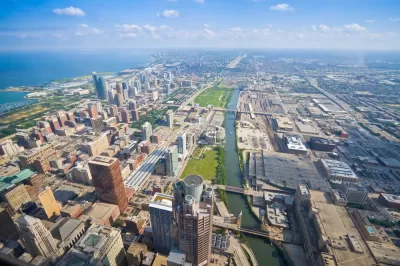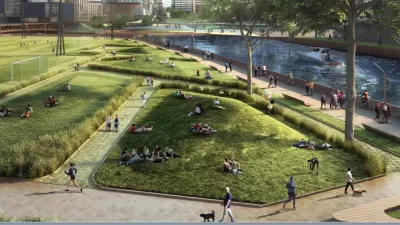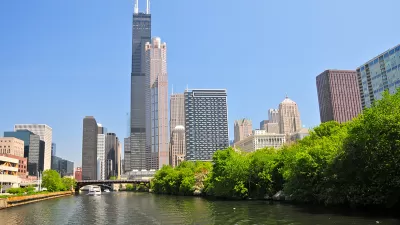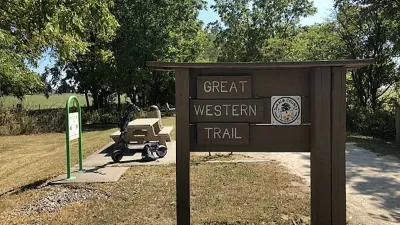The Chicago River is attracting some of the city's most creative visions for the future. The second plan in recent months proves the potential of the river as an open space asset.

Mary Wisniewski reports on a new effort in Chicago to restore the Chicago River. The premise that opens the article: that while Chicago's lakefront is a triumph of planning as the city's frontyard, the river has suffered from long neglect.
Though Daniel Burnham included riverfront promenades in his 1909 Plan for Chicago, most of the land along the river has long been inaccessible or unappealing — a mix of scrub trees and litter, industry and private property. The river was known mainly for pollution, and the fact that it was engineered to flow backward.
Wisniewski's discussion about the Chicago River is set in the context of a new plan for a "continuous bike and pedestrian trail along the entire 27-mile Chicago riverfront by 2030." The plan by the Active Transportation Alliance aims to make the river the city's backyard.
"The ideas for new trail segments range from the more easily achievable — developers on the riverfront south of the Loop including a trail as part of their project, for example — to more complicated ideas such as putting stationary or floating docks over the water in places where it is tough to build on land," according to Wisniewski.
The Chicago River Trail plan builds on another big plan for the Chicago River announced in August. The "Our Great River" plan included a discussion of a continues trail along the river but the "Alliance's preliminary report took it a step further and supplied details about how it could work."
FULL STORY: Ambitious proposal would make Chicago River the city's new backyard

Alabama: Trump Terminates Settlements for Black Communities Harmed By Raw Sewage
Trump deemed the landmark civil rights agreement “illegal DEI and environmental justice policy.”

Planetizen Federal Action Tracker
A weekly monitor of how Trump’s orders and actions are impacting planners and planning in America.

Why Should We Subsidize Public Transportation?
Many public transit agencies face financial stress due to rising costs, declining fare revenue, and declining subsidies. Transit advocates must provide a strong business case for increasing public transit funding.

Understanding Road Diets
An explainer from Momentum highlights the advantages of reducing vehicle lanes in favor of more bike, transit, and pedestrian infrastructure.

New California Law Regulates Warehouse Pollution
A new law tightens building and emissions regulations for large distribution warehouses to mitigate air pollution and traffic in surrounding communities.

Phoenix Announces Opening Date for Light Rail Extension
The South Central extension will connect South Phoenix to downtown and other major hubs starting on June 7.
Urban Design for Planners 1: Software Tools
This six-course series explores essential urban design concepts using open source software and equips planners with the tools they need to participate fully in the urban design process.
Planning for Universal Design
Learn the tools for implementing Universal Design in planning regulations.
Caltrans
Smith Gee Studio
Institute for Housing and Urban Development Studies (IHS)
City of Grandview
Harvard GSD Executive Education
Toledo-Lucas County Plan Commissions
Salt Lake City
NYU Wagner Graduate School of Public Service





























